Bottom feeder fish have a special place in my heart and aquariums. Bottom-dwellers can add variety and help maintain a healthier environment in your aquarium.
Adorable oddballs, they can easily be the cornerstone species of a tank. In case you can’t tell, I think they’re awesome and I highly recommend them.
In this guide, I’ll take you through the physiology of bottom feeder fish, the best types, and what you should avoid so you don’t end up with a catfish that outweighs your dog.
Physiology of Bottom Feeders
Bottom feeders are fish that primarily live and eat…well…at the bottom of the aquarium.
Instead of grabbing food from the surface or midwater, bottom feeders find their food along the substrate.
Some are scavengers that normally eat dead fish and invertebrates. Others are herbivores that eat mostly algae and other plant materials. And some, like pictus catfish, are even predators.
Let’s go over the key characteristics of bottom feeders.
Inferior Mouth
Bottom feeders have evolved specialized traits that help them survive at or near the substrate.
They have what’s known as an inferior mouth. I know, weird term, but it refers to where the mouth is located on the body, not it’s quality or performance.
An inferior mouth is located more towards the bottom of the fish’s body and is usually pointed downwards. That way, the fish can root around in the substrate for tasty treats but still keep its eyes looking up for predators.
Barbels
Many bottom feeders have barbels, fleshy whiskers that grow on or near their mouths. Barbels help fish find food. Not only are they really sensitive to touch, but they also have tasting cells on them, almost like a tongue.
So even if just the outside of the mouth touches something edible, the fish can taste it and find it.
Suckermouths
Some species of bottom feeders have highly specialized mouths, like plecos and oto cats, that let them latch onto surfaces and scrape algae or biofilm. Their mouths are round and look a lot like a suction cup.
This kind of mouth also helps them stay in place to feed even if they are in fast moving waters.
Flat Ventral Region
A lot of bottom feeders have a common body shape. They have a flattened ventral region, which is fancy scientist talk for flat bellies. This lets them more easily rest and move along the bottom.
In some bottom feeders, like koi, the flat ventral region isn’t that severe.
For others, their ventral region is so flattened that the fish doesn’t look like a fish at all, such as Chinese hillstream loaches and stingrays.
And of course, there are a bunch in between these two extremes, like cory cats.
Best Bottom Feeder Fish List For Freshwater Aquariums
Now let’s go over some types of bottom feeder fish commonly found in the aquarium trade.
Going over every individual species is impossible to do in a single article.
Instead, let’s look at some of the major groups of bottom feeders and I’ll mention a few standout species from each one.
1. Bristlenose Pleco (Ancistrus)
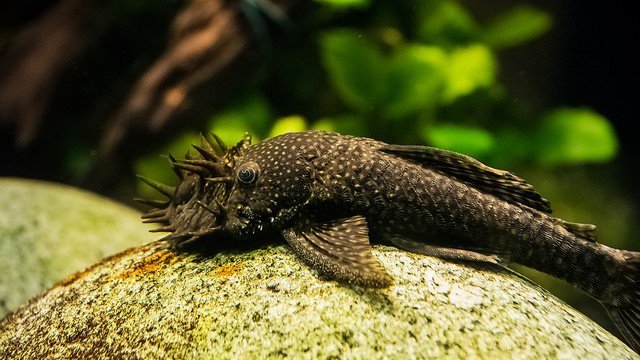
- Origins: South America
- Behavior: Plecos are shy cave-dwelling fish. They are nocturnal so they hide in a cave or under a submerged log during the day and emerge to feed on plants and algae at night.
- Compatibility/Temperament: Plecos are mostly peaceful. They pretty much ignore other fish, but they can be aggressive towards other plecos. They sometimes get into scrapes with other fish over their favorite hiding spot.
- Size: 3-24 inches (4.7-61 centimeters) depending on species
- Lifespan: 10-15 years
- Tank size: 30-125 gallons (110-475 liters)
- Temperature: 75°-82°F (23.8°-27.7°C)
- pH: 6.5-7.5
- Plants and decor: Plecos need a hiding spot to hang out in during
Bristlenose plecos are suckermouthed catfish from South America. They’re a go-to bottom feeder fish, commonly added to aquariums as part of the substrate and algae cleanup crew.
Make sure to research a species before you decide to buy it.
There are some, like clown plecos (Panaque maccus) or bristlenose (Ancistrus sp.), that grow to be less than 6 inches (<15 centimeters).
But there are other types of pleco, like the common pleco (Hypostomus plecostomus) or sailfin plecos (Pterygoplichthys gibbiceps), that can grow to be really large, 18-24 inches (46-61 centimeters).
The species you see the most often in live fish stores can grow to be giant tank busters. Buyer beware!
Plecos can really add to the bioload of an aquarium. Since they eat almost constantly, they put off a lot of waste. It’s better to put them in as large an aquarium as possible.
2. Corydoras Catfish (Corydoras melanotaenia)
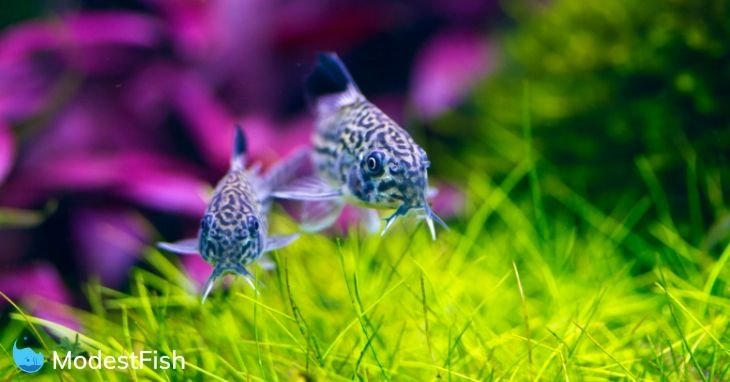
- Origins: South America
- Behavior: Cories are an active schooling fish. They really need a group of 6 or more to feel secure and happy.
- Compatibility/Temperament: Cories are really peaceful. They may have little squabbles amongst themselves, but this is lessened by keeping them in a big group.
- Size: 1-3.5 inches (2.5-9 centimeters)
- Lifespan: 3-5 years
- Tank size: 20 gallons (75 liters)
- Temperature: 70°-75°F (21.1°-23.8°C)
- pH: 6.0-8.0
It’s hard to find fish that are cuter than cory cats. I really love these guys. They always remind me of a bunch of little kids playing, or maybe a pack of puppies.
They flit around and scour the bottom of the tank all day long.
Cories stay relatively small. For example, emerald cories (Corydoras splendens) are the big bruisers, coming in at a whopping 3.5 inches (9 centimeters).
Dwarf (Corydoras hastatus) and panda cories (Corydoras panda) are really tiny and only get about an inch long.
Pro Tip: Cories love to root around in the substrate all day. They can scratch and injure themselves on sharp substrates, like blasting sand. Go with smoother substrate like Caribsea Super Natural Sunset Gold.
3. Botia Loaches (Botia striata)
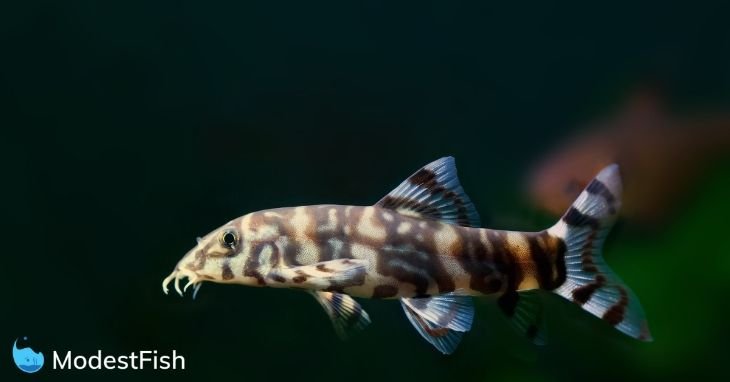
- Origins: Southeast Asia
- Behavior: Loaches switch between manically scouring the substrate and lounging around like a kid watching cartoons. They love to pile in on top of one another to hide or rest.
- Compatibility/Temperament: Most loaches are highly social and need a school of 5 or more. Most species do fine in a peaceful community tank, but be careful. Being kept in too small a group can make them more aggressive.
- Size: 2-12 inches (5-30 centimeters)
- Lifespan: 10-20 years (there are some reports of clown loaches living up to 50 years)
- Tank size: 30-150 gallons (110-570 liters)
- Temperature: 75°-85°F (23.8°-29.4°C)
- pH: 6.0-7.0
Botia loaches are a bottom feeder fish I have seriously considered dedicating an entire tank to. I’ve always found their coloration and behavior really interesting.
Be sure to research the species as some of these guys can get VERY large, especially clown loaches (Chromobotia macracanthus).
Sure they’re little and cute in the store tank, but those are juveniles that can grow up to a foot in length and require at least a 100 gallon (380 liter) tank.
Luckily, there are some smaller varieties, like zebra (Botia striata) and dwarf chain loaches (Ambastaia sidthimunki).
There are some varieties that can be very scrappy and are really not suited to a community tank. Skunk loaches and blue botia can be very aggressive with other fish.
4. Otocinclus Catfish (Otocinclus arnoldi)
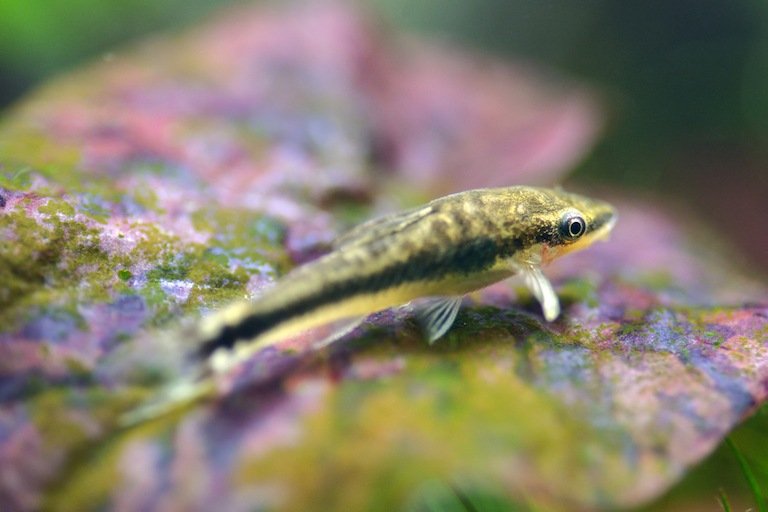
- Origins: South America
- Behavior: Oto cats are an active schooling fish that does best in a group of 10 or more.
- Compatibility/Temperament: These little guys are very peaceful and should be kept with other small, peaceful community fish.
- Size: 1.5-2 inches (4-5 centimeters)
- Lifespan: 3-5 years
- Tank size: 20 gallons (75 liters)
- Temperature: 70°-78°F (21°-25.5°C)
- pH: 6.5-7.5
There are at least 17 different species in the genus Otocinclus, but the most commonly imported species is Otoclinus vittatus. It’s possible to breed this species in an aquarium, but most of them are wild caught in South America.
In their natural habitat, these fish shoal together in huge numbers, with thousands of individuals coming together in a group.
In the aquarium, they are voracious algae eaters that will constantly graze along plants, decor and tank glass.
This is another adorable little species that is a lot of fun to watch, especially when they’re kept in the right numbers. They need to be kept in a school of at least 10.
They can have a tough time acclimating and I really recommend that they only be added to a mature, well cycled tank.
5. Synodontis Catfish (Synodontis nigriventris)
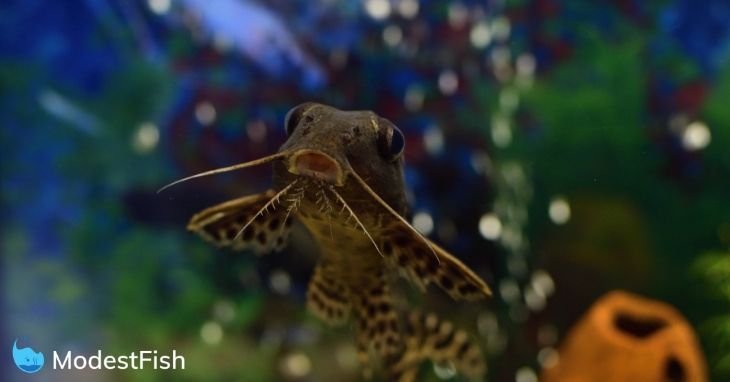
- Origins: Africa
- Behavior: Synodontis are nocturnal, but you’ll often see them pop out of their hidey holes during the day to cruise around the tank, especially if there’s food.
- Compatibility/Temperament: Peaceful, but robust enough to hang out with African cichlids.
- Size: 4-10 inches (10-25.5 centimeters)
- Lifespan: Up to 10 years
- Tank size: 30 gallons (110 liters)
- Temperature: 72°-77°F (22.2°-25°C)
- pH: 7.5-8.2
- Plants and decor: Synodontis need multiple caves and hiding places around the tank to feel secure.
I love this genus of catfish. They originate from the rivers and lakes of Africa and are the perfect addition for many cichlid tanks. They can be shy, but are still really active.
There are over 300 identified species of Synodontis and many of them are available in the aquarium trade.
I’ve kept several species, including Synodontis multipunctatus and Synodontis angelica. I’ve always really enjoyed them. I have a multipunctata in one of my tanks now; his name is Norman.
I think they have great personalities and are really interesting to watch.
They can definitely squabble amongst themselves, but they are very peaceful when it comes to other fish. I’ve seen them ignore smaller fish that they could have eaten if they really wanted to.
Some species can get over 9 inches long (23 centimeters). But, there are also dwarf varieties, like Synodontis petricola, that only get to 4 inches (10 centimeters).
6. Kuhli Loaches (Pangio kuhlii)
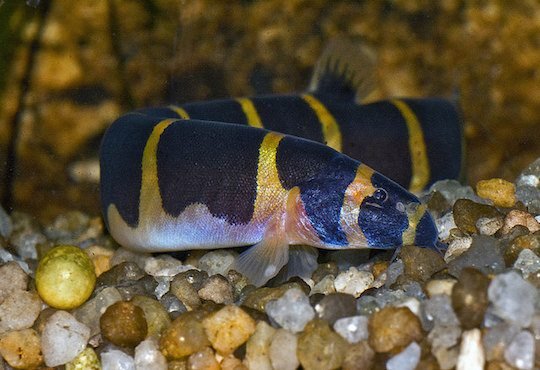
- Origins: Southeast Asia
- Behavior: These little guys are mostly nocturnal and will hide during the day. At night, they emerge and scour the bottom of the tank looking for uneaten food.
- Compatibility/Temperament: Kuhli loaches are super peaceful. They like to be kept in a group of six or more.
- Size: 3-5 inches (7.6-13 centimeters)
- Lifespan: Up to 10 years
- Tank size: 20 gallons (75 liters)
- Temperature: 75°-85°F (24°-29.5°C)
- pH: 5.5-6.5
- Plants and decor: Kuhli loaches need a dark hiding spot to hang out in during the day. They also really appreciate a heavily planted tank.
Kuhli loaches (Pangio kuhlii) are another kind of fish that’s so weird looking it’s cute. They look like a little eel.
These little guys are really good at hiding, like really good. My friend has six of them in a 40 gallon (150 liter) that he just couldn’t find for several months. He thought they had died and been eaten by other fish.
Then he did a major overhaul of the tank and realized they had buried themselves in the substrate under a sponge filter at the back of the tank.
They’re also really fond of hiding in undergravel filters.
Kuhli loaches are mostly nocturnal, but some will pop out of their hiding places at meal times. It’s really important to give them lots of shady hiding spots to retreat to during the day.
7. Ornamental Shrimp
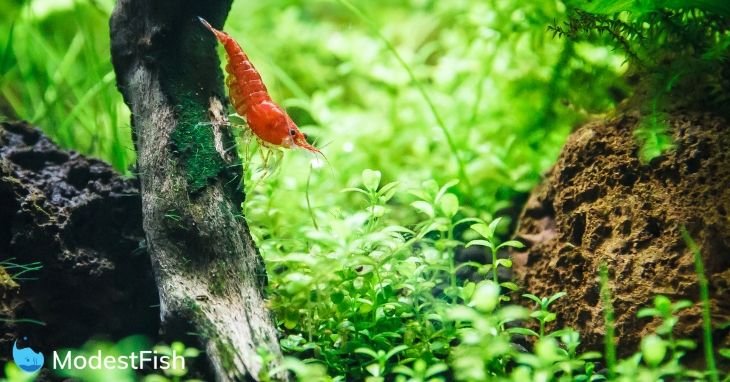
- Origins: Southeast Asia
- Behavior: Active grazers that will swarm all over the tank daily in search of food.
- Compatibility/Temperament: Very peaceful, can fall victim to large and/or aggressive fish.
- Size: 1-2 inches ( 2.5-5 centimeters)
- Lifespan: 1-2 years
- Tank size: 5 gallons (19 liters)
- Temperature: 68°-75°F (20°-23.8°C)
- pH: 6.0-8.0 (research species carefully)
- Plants and decor: Shrimp will do best in a heavily planted tank.
When you’re considering bottom feeders, don’t forget these little invertebrates. Freshwater shrimp will constantly graze on algae, biofilm and food that gets past your fish.
They’ve only been in the hobby since about 2004 but they have become wildly popular. There are many species to choose from, like Amano shrimp (Caridina multidentata), cherry shrimp (Neocaridina davidi) or black crystal shrimp (Caridina cf. cantonensis).
One thing to keep in mind, each species has its own preferred water conditions. As always, research the species and make sure that they’ll be a good fit for your tank.
Also, there are lots of fish out there that think shrimp are very tasty…because they are. Shrimp should really only be kept with small, peaceful community fish.
Pro Tip: Every species of shrimp has particular needs when it comes to water hardness. In my experience, it’s better to go with a species that is a good match for your water rather than trying to alter your water to match a species.
8. Snails
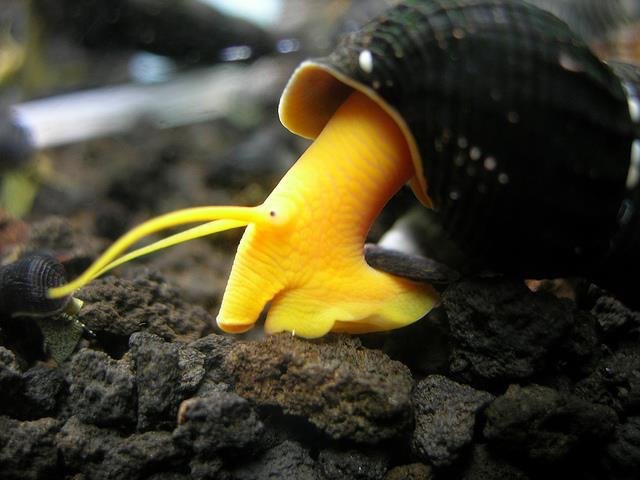
- Origins: South America, Southeast Asia and Africa
- Behavior: Glide around on surfaces, eating algae and detritus.
- Compatibility/Temperament: Peaceful
- Size: inches 1-2 inches (2.5-5 centimeters)
- Lifespan: 1 year
- Tank size: 10 gallons (37 liters)
- Temperature: 70°-80°F (21°-26.6°C)
- pH: 6.5-8.0
- Plants and decor: Some species of freshwater snails will just eat algae off of live plants. But, others will devour and kill live plants. Make sure to research the species before bringing it home.
Snails can really help to beat back algae and eat up food that gets past your fish.
I really like nerites (Neritina sp.). There are several species of aquarium snails available and they’re really pretty. Nerites are like algae hoovers.
They lay eggs in freshwater, but they can’t hatch unless they’re in brackish or saltwater.
There are other species, like mystery snails (Pomacea bridgesii), that can reproduce in freshwater, but only if you have a male and a female. If you only have one, no baby snails.
Snails will eat algae on most surfaces in your tank and will gobble up uneaten food off the substrate.
Just be aware, since they eat constantly, they poop constantly. So they can have a major impact on your water quality.
Pro Tip: Snails, and other invertebrates, are very sensitive to copper. Do not use copper-based medications, like Mardel Coppersafe or Seachem Cupramine, if you have snails or shrimp in your tank.
Worst Types of Bottom Feeder Fish
It’s not that I’m saying that I dislike these guys. Some of them are actually pretty cool. But, the average hobbyist can’t provide what they need long term or they’re a nuisance.
Some of the species I’m about to go over need 1,000 gallon (3,800 liters) tanks, if not larger. I really don’t think they should be sold in the hobby, but sadly, I’m not in charge of these decisions.
9. Chinese Algae Eaters (Gyrinocheilus aymonieri)
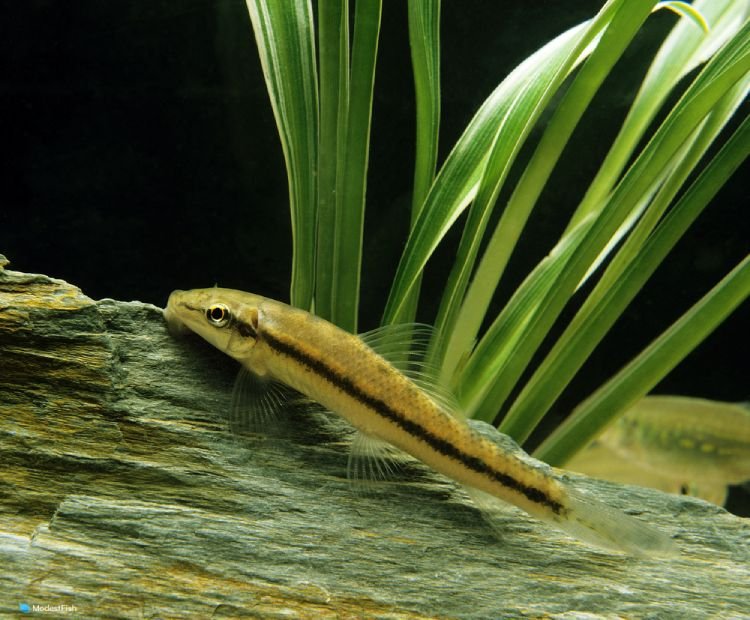
These guys are not the best choice for a lot of tanks. They can get up to 10 inches (25 centimeters) and can get pretty aggressive when they become adults.
They will commonly latch onto the sides of tank mates to eat the slime coat, damaging the scales and skin of the other fish. You need at least a 55 gallon (210 liters) tank to keep these.
10. Tiger Shovelnose Catfish (Pseudoplatystoma fasciatum)
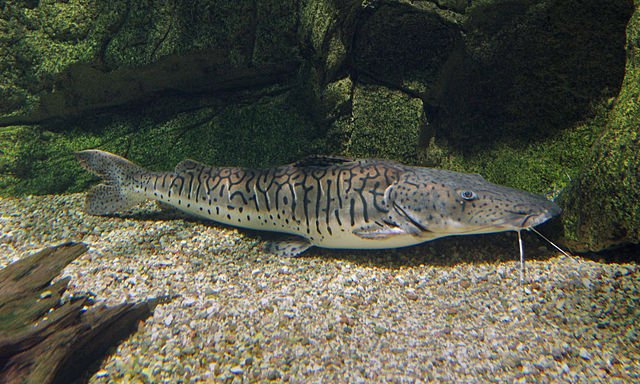
This fascinating catfish also comes from South America and can grow to over 3 feet (0.9 meters). They are very aggressive and will eat any tank mate that will fit in their mouths. They require at least a 400 gallon (1,500 liters) aquarium.
11. Channel Catfish (Ictalurus punctatus)
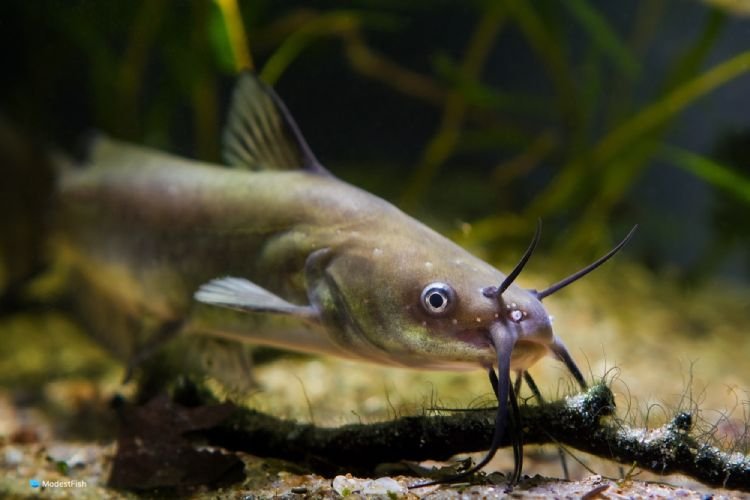
These bad boys can reach 2-3 feet (0.6-0.9 meters) and weigh over 50 pounds (22.6 kilograms). This is actually the species that aquaculturists raise on fish farms in the United States.
They are tasty, but unless you have at least a 300 gallon (1,100 liters) aquarium, don’t bring one home as a pet.
12. Redtail Catfish (Phractocephalus hemioliopterus)
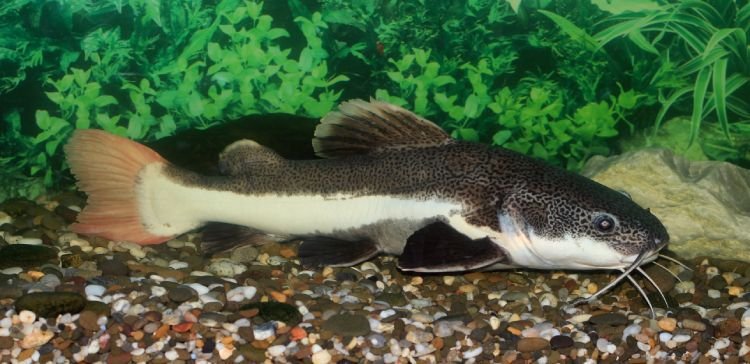
This South American behemoth rapidly grows to 4-6 feet (1.2-1.8 meters) and requires at least a 1,000 gallon (3,800 liter) tank. It will also happily eat up all your other fish as it grows.
13. Apple Snails
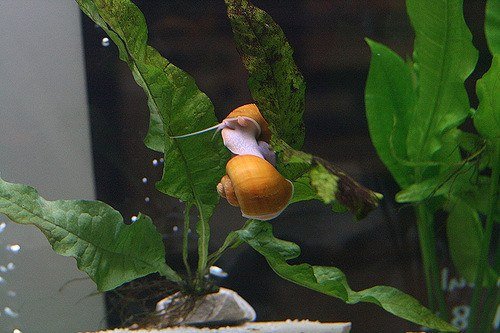
I really don’t recommend apple snails (Pomacea canaliculata). They get really big, really quickly, and they breed like crazy. They can very quickly become a pest and they will utterly destroy live plants.
Bottom Feeders Roll In Aquarium Care
In my opinion, bottom feeders are a great addition to almost any aquarium. And it’s their feeding strategies that makes them so desirable.
They’re commonly low-maintenance fish, who’ll spend their time cleaning your tank by eating up leftover fish food and decaying plant matter.
My rainbow fish are seriously messy eaters and a lot of food gets past them. If it weren’t for bottom feeders, all that food that sinks past the rainbows would really foul up my water.
This helps keep the tank cleaner and your water parameters balanced because there isn’t a bunch of food rotting on the substrate. A lot of bottom feeders will also eat algae. This’ll ensure your plants are able to get enough resources and keep the aesthetic appeal of your tank.
I also like to add bottom feeder fish because they add another layer of interest into the aquarium.
They come in so many shapes and colors. And each species has its own behavior patterns. There are some tanks where I decided on the bottom feeders before I even picked out my “centerpiece” fish.
Is a Bottom Feeder Right for You?
Like I mentioned, bottom feeders have a special place in my heart.
But seriously, I really do like all of the different species of bottom feeders available in the aquarium trade.
They add variety and are useful cleaner fish that help maintain a healthier environment in your aquarium.
It’s best to research the species you’re thinking of buying. That way, you know exactly what you’re getting into and don’t end up with a catfish that outweighs most people’s dogs.
Many bottom feeder fish are adorable oddballs that could easily be the cornerstone species of a tank in my opinion. In case you can’t tell, I think they’re awesome and I highly recommend them.

Thanks so much, We got some ideas from the info you’ve shared to Us, thanks again, Katherine Morgan 🙂
Excellent advice, I’ve really learned a lot. Thank you. Linda
Thanks for the helpful information. I love this hobby and I appreciate the help.
Thanks for sharing the information. I really need a lot of the information.